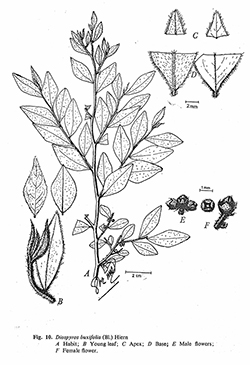e-Flora of Thailand
Volume 2 > Part 4 > Year 1981 > Page 305 > Ebenaceae > Diospyros
10. Diospyros buxifolia (Blume) Hiernwfo-0000648612
Trans. Camb. Phil. Soc. 12. 1: 218. 1873; Lecomte in Fl. Gén. I.-C. 3: 951. 1930; Bull. Jard. Bot. Btzg Sér. 3. 15: 97. 1937; H.R.Fletcher in Fl. Siam. En. 2: 365. 1938; Ng, Mal. For. 40. 4: 215. 1977.— Leucoxylum buxifolium Blume, Bijdr: 1169. 1826. Fig. 10.
Accepted Name : This is currently accepted.
Synonyms & Citations :
Description : Evergreen tree, up to 25 m high, twigs unarmed. Leaves elliptic, subrhomboid or ovate, subsessile, 1.2–4 by 0.5–2 cm, base acute, obtuse or rounded, apex acute, obtuse or mucronate, chartaceous, brown when dry, glabrous except pubescent along midrib on upper surface, sericeous later glabrescent, except along midrib on lower surface; secondary nerves inconspicuous. Male flowers cymose or solitary, 4-merous, sessile. Calyx campanulate, 2–3 mm long, divided to half or three fifths, pubescent outside, glabrous inside. Corolla campanulate, 2–4 mm long, divided to two thirds, glabrous on both sides, pubescent along mid-line of lobes outside. Stamens 8–20; anthers glabrous; filaments pilose. Rudimentary ovary pilose. Female flowers solitary, 4-merous; pedicel 1–2 mm long, pubescent. Calyx and Corolla as in male flowers, but larger. Ovary conical, glabrous, 4-locular; styles 2, pubescent in the lower half. Staminodes absent. Fruit ellipsoid or conical, 1–1.5 by 0.4–1 cm, dry, ± glabrous, obtuse at both ends; fruiting calyx campanulate, divided to middle; pubescent outside, glabrous inside; lobes not reflexed, neither plicate nor undulate and with inconspicuous nerves; fruit-stalk ± 5 mm long; endosperm smooth.
Thailand : SOUTH-EASTERN: Prachin Buri; PENINSULAR: Nakhon Si Thammarat, Phangnga, Ranong, Satun, Trang.
Distribution : India, Cambodia, Vietnam, Malay Peninsula, Indonesia (type), the Philippines.
Ecology : In tropical rain forests and dry evergreen forests, 50–500 m alt. Flowering: January–May; fruiting: April–June.
Vernacular : Ri phao(ริเภา), sang tham(สั่งทำ)(Peninsular).
Uses: Timber used for posts and poles.

